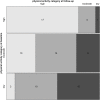No Evidence for a Decrease in Physical Activity Among Swiss Office Workers During COVID-19: A Longitudinal Study
- PMID: 33688857
- PMCID: PMC7928288
- DOI: 10.3389/fpsyg.2021.620307
No Evidence for a Decrease in Physical Activity Among Swiss Office Workers During COVID-19: A Longitudinal Study
Abstract
Purpose: The COVID-19 lockdown interrupted normal daily activities, which may have led to an increase in sedentary behavior (Castelnuovo et al., 2020). The aim of this study was to investigate the effect of the COVID-19 pandemic on the level of physical activity among Swiss office workers.
Methods: Office workers from two Swiss organizations, aged 18-65 years, were included. Baseline data from January 2020 before the COVID-19 pandemic became effective in Switzerland were compared with follow-up data during the lockdown phase in April 2020. Levels of physical activity were assessed using the International Physical Activity Questionnaire. Paired sample t-tests or Wilcoxon signed-rank test were performed for statistical analysis.
Results: Data from 76 participants were analyzed. Fifty-four participants were female (71.1%). The mean age was 42.7 years (range from 21.8 to 62.7) at baseline. About 75% of the participants met the recommendations on minimal physical activity, both before the COVID-19 pandemic and during the lockdown. Weak statistical evidence for a decline in total physical activity in metabolic equivalent of task minutes per week (MET min/week) was found (estimate = -292, 95% CI from - ∞ to 74, p-value = 0.09), with no evidence for a decrease in the three types of activity: walking (estimate = -189, 95% CI from - ∞ to 100, p-value = 0.28), moderate-intensity activity (estimate = -200, 95% CI from - ∞ to 30, p-value = 0.22) and vigorous-intensity activity (estimate = 80, 95% CI from - ∞ to 460, p-value = 0.74). Across the three categories "high," "moderate," and "low" physical activity, 17% of the participants became less active during the lockdown while 29% became more active.
Conclusion: The COVID-19 pandemic did not result in a reduction in total physical activity levels among a sample of Swiss office workers during the first weeks of lockdown. Improved work-life balance and working times may have contributed to this finding.
Clinical trial registration: www.ClinicalTrials.gov, NCT04169646. Registered 15 November 2019 - Retrospectively registered, https://clinicaltrials.gov/ct2/show/NCT04169646.
Keywords: COVID-19; SARS-CoV-2; coronavirus; health promotion; lockdown; physical exercise; public health; shutdown.
Copyright © 2021 Aegerter, Deforth, Sjøgaard, Johnston, Volken, Luomajoki, Dratva, Dressel, Distler, Melloh, Elfering and the NEXpro Collaboration Group.
Conflict of interest statement
The authors declare that the research was conducted in the absence of any commercial or financial relationships that could be construed as a potential conflict of interest.
Figures



References
-
- Aegerter A. M., Deforth M., Johnston V., Ernst M. J., Volken T., Luomajoki H., et al. (2020). On-site multi-component intervention to improve productivity and reduce the economic and personal burden of neck pain in Swiss office-workers (NEXpro): protocol for a cluster-randomized controlled trial. BMC Musculosk. Disord. 21:391. 10.1186/s12891-020-03388-x - DOI - PMC - PubMed
-
- Bland M. (2015). An Introduction to Medical Statistics. Oxford: Oxford University Press.
-
- Bundesamt für Statistik (BFS) (2020). Schweizerische Arbeitskrafterhebung (SAKE). Available online at https://www.bfs.admin.ch/bfs/de/home/statistiken/arbeit-erwerb/erwerbsta.... (accessed 09.01.2021).
Associated data
LinkOut - more resources
Full Text Sources
Other Literature Sources
Medical
Miscellaneous

